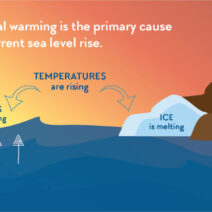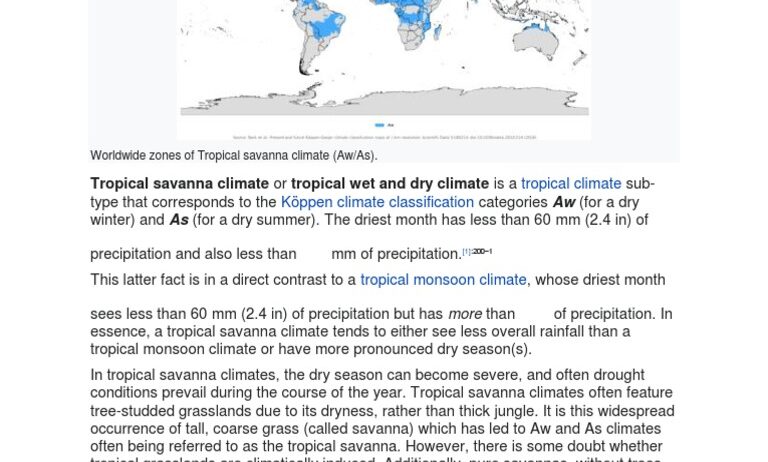The climate of the tropical savanna is characterized by distinct wet and dry seasons, creating an environment that is both complex and vital to the Earth’s ecology. This unique climate typology is primarily situated near the equator, where it typically lies between the tropical rainforest and desert biomes, receiving a marginal amount of precipitation compared to more temperate regions. Understanding the nuances of this climate can illuminate not only the conditions under which various flora and fauna thrive but also highlight the significant challenges posed by climate change.
To grasp the essence of the tropical savanna climate, one must first delve into its geographic distribution. Predominantly found in regions like east Africa, Brazil, and parts of Australia, the savanna’s climate is governed by the Intertropical Convergence Zone (ITCZ). This zone, a climactic band where moist tropical air converges, shifts seasonally, dictating the alternating patterns of rainfall and dry spells that typify the tropics.
During the wet season, which generally spans several months, areas that are classified as tropical savannas experience significantly higher levels of precipitation, often exceeding 1,200 millimeters annually. This period can last from May to October in many regions, coinciding with the monsoon in some places. The humidity during these months fosters the growth of exuberant grasslands and scattered trees, creating habitats rich in biodiversity. Animal species such as elephants, giraffes, and various antelope thrive amidst these lush environments, taking advantage of the abundant food sources.
However, the dry season, typically lasting from November to April, poses a stark contrast. During this time, precipitation is minimal, often dropping below 250 millimeters for the entire duration. Dry winds are common, contributing to the parched conditions that envelop the savanna. The landscape transforms remarkably; rivers and streams dwindle, and many vegetation species enter a state of dormancy to conserve water. Animals adapted to this climate, like the zebra and the wildebeest, migrate in search of food and water, illustrating the dynamic interplay of survival in the face of climatic fluctuations.
Temperature plays a critical role in the tropical savanna climate. From a climatological perspective, temperatures remain consistently high, averaging between 20°C to 30°C throughout the year. This stability allows for a diverse array of ecological interactions, but it also exacerbates the effects of climate change, as increased temperatures can lead to intensified droughts, impacting not only wildlife but also human populations that depend on these ecosystems for livelihood.
One notable aspect of the tropical savanna climate is its resilience and adaptability. Many plant species have evolved characteristics such as deep root systems to access subterranean water, bark that is resistant to fire, and leaves that can minimize water loss. These adaptations are crucial, as wildfires are a natural occurrence in savanna ecosystems, occurring most frequently during the dry season. Fire acts as a regenerative force, clearing old and excessive plant material, allowing for fresh regrowth and maintaining the balance within the ecosystem.
Human interactions with tropical savanna climates are multifaceted and often contentious. Many communities rely on agriculture and pastoralism, practices deeply entwined with the seasonal rhythms of the land. However, unsustainable land use practices, such as deforestation or overgrazing, can lead to soil degradation and weakened ecosystem resilience. Such actions not only threaten the biological diversity but also exacerbate the vulnerability of the climate to further change.
The impending threats of climate change are pressing issues that many tropical savanna regions face today. Predicted alterations in rainfall patterns, increasing frequency, and intensity of droughts pose significant risks to both wildlife habitat and agricultural productivity. As the planet warms, the delicate balance of the savanna ecosystem is under jeopardy, requiring urgent attention and adaptive management strategies.
The role of conservation cannot be understated in these scenarios. Various initiatives focus on protecting and restoring tropical savanna ecosystems by promoting sustainable agricultural practices and rehabilitating degraded areas. Such measures not only serve to safeguard biodiversity but also enhance the resilience of these climates in the face of ongoing environmental challenges.
In conclusion, the tropical savanna climate is an intricate tapestry of biological and ecological interactions, shaped profoundly by its wet and dry seasons. The seasonal shifts engender a rich diversity of life yet pose considerable challenges, particularly as the effects of climate change become ever more pronounced. Understanding these dynamics is crucial for effective conservation and management strategies aimed at preserving these irreplaceable ecosystems, which are vital to both the planet’s health and the livelihoods of countless communities that inhabit them.
While the beauty of the tropical savanna is evident, it necessitates a deeper appreciation of the climatic forces at play and the need for vigilant stewardship. The fragility of this environment underscores the urgency of adopting sustainable practices and fostering resilience against the unyielding tides of climate change. In summary, the tropical savanna represents a critical component of our global ecological landscape, deserving of thorough understanding and concerted efforts towards its preservation.







